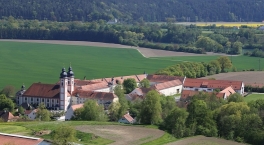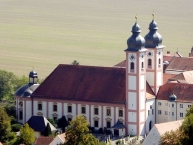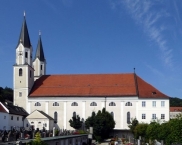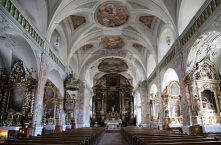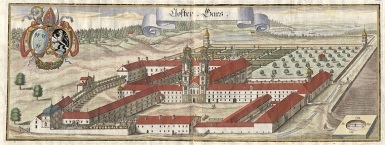Radweg Benediktweg
Aktionen
![]()
Bitte warten - Kartendaten werden geladen
Erstellt am 30.01.2014,
zuletzt geändert von biroto-Redaktion am 23.11.2020
Aktionen
Strecken-Merkmale
Gesamtlänge in km
241
Informationen zu Rechten an den GPS-Track-Daten | |
|---|---|
Rechte-Inhaber | OpenStreetMap and Contributors + biroto-Redaktion (biroto.eu) |
Rechte-Ausprägung / Lizenz | Enthält Daten von OpenStreetMap, die hier unter der Open Database License(ODbL) verfügbar gemacht werden |
Link zur Rechtebeschreibung | |
gpx-Datei übernommen aus | |
gpx-Datei hochgeladen | durch biroto-Redaktion am 23.11.2020
|
Gesamtzahl Trackpoints
4.865
Trackpoint-Dichte per km
20
Endorte
Start
Mühldorf a. Inn, Bayern, DE (392 m NHN)
Ziel
Mühldorf a. Inn, Bayern, DE (392 m NHN)
Charakter
Mit der Bezeichnung Benediktweg wurde am 17. August 2005 ein neuer Pilgerweg eröffnet. Er verbindet die Stätten der Kindheit und der Jugend von Papst Benedikt dem XVI. (Joseph Ratzinger) im südöstlichen Oberbayern.
Der 248 Kilometer lange Rundweg mit Beginn und Ende in Altötting ist für Menschen gedacht, die als Pilger mit dem Rad die geistigen und spirituellen Zentren der traditionsreichen Kulturlandschaft zwischen Salzach und Inn erkunden wollen.
Informationen zu Urheber-Rechten | |
|---|---|
Rechte-Ausprägung / Lizenz | by-sa: CREATIVE COMMONS Namensnennung, Weitergabe unter gleichen Bedingungen |
Link zur Rechtebeschreibung | |
Text(e) übernommen von: |
Seite „Benediktweg“. In: Wikipedia, Die freie Enzyklopädie. Bearbeitungsstand: 4. Oktober 2013, 07:33 UTC. URL: http://de.wikipedia.org/w/index.php?title=Benediktweg&oldid=123128195 (Abgerufen: 30. Januar 2014, 11:49 UTC) |
übernommen / bearbeitet am | 30.01.2014
|
übernommen / bearbeitet durch |
|
Wegweisung
|
Informations-Quellen
Web-Seiten:
- Offizielles Portal des Benedikt-Weges
Fahrradfreundliche Unterkünfte, Sehenswertes und Infrastruktur
Name u. Anschrift
Breite / Länge
Tel.
Fax.
Mobile
Art d. Unterkunft
Radler-freund-lichkeit
Strecken-km
km zur Strecke
Höhe
21 km
0,9 km
468 m
25 km
0,0 km
419 m
Informationen zu Urheber-Rechten | |
|---|---|
Rechte-Inhaber | |
Rechte-Ausprägung / Lizenz | by-sa: CREATIVE COMMONS Namensnennung, Weitergabe unter gleichen Bedingungen |
Link zur Rechtebeschreibung | |
Bild übernommen aus | https://commons.wikimedia.org/wiki/File:Kloster_Au_am_Inn_Gars-1.jpg |
Bild hochgeladen | durch biroto-Redaktion am 23.11.2020
|
Informationen zu Urheber-Rechten | |
|---|---|
Rechte-Inhaber | |
Rechte-Ausprägung / Lizenz | by-sa: CREATIVE COMMONS Namensnennung, Weitergabe unter gleichen Bedingungen |
Link zur Rechtebeschreibung | |
Bild übernommen aus | https://commons.wikimedia.org/wiki/File:Kirche_Au_am_Inn_von_Nordwesten,_7.jpeg |
Bild hochgeladen | durch biroto-Redaktion am 23.11.2020
|
Informationen zu Urheber-Rechten | |
|---|---|
Rechte-Inhaber | |
Rechte-Ausprägung / Lizenz | by-sa: CREATIVE COMMONS Namensnennung, Weitergabe unter gleichen Bedingungen |
Link zur Rechtebeschreibung | |
Bild übernommen aus | |
Bild hochgeladen | durch biroto-Redaktion am 23.11.2020
|
Das Kloster Au/Äu ist ein ehemaliges Augustiner-Chorherrenstift und jetziges Franziskanerinnenkloster bei Au am Inn in Bayern im Erzbistum München und Freising.
Geschichte
Um 780 wurde durch die Mönche Baldung (Balduin) und Hrodbert eine Zelle gegründet. 1122 wurde von Erzbischof Konrad I. von Salzburg ein Augustinerchorherrenstift gegründet, das der Heiligen Maria, St. Felicitas und St. Vitalis geweiht war.
Etwa 1000 Handschriften gingen mit einem Brand der Stiftsbibliothek im Jahr 1686 verloren. Der Graubündner Domenico Cristoforo Zuccalli setzte ab 1687 einen bereits vorher begonnenen Neubau der Konventsgebäude fort und ließ bis 1711 eine schlossartige Anlage im Barockstil mit mehreren Innenhöfen und der zweitürmigen Stiftskirche St. Maria entstehen. Deren Ausstattung mit Deckenfresken und Altarbildern wurde von Franz Mareis aus Wasserburg bis zur Mitte des 18. Jahrhunderts fertiggestellt.
Das Kloster wurde 1803 im Zuge der Säkularisation aufgelöst. Die kulturhistorisch bedeutsame, von Domenico Christoforo Zuccalli entworfene Kirche wurde Pfarrkirche, das Kloster gelangte in den Privatbesitz von Joseph Ernst von Koch-Sternfeld. 605 Bücher der Klosterbibliothek erhielt die Universitätsbibliothek in Landshut. 1853 übernahmen Dillinger Franziskanerinnen aus Dillingen an der Donau die Klostergebäude. 1854 wurde die unabhängige Kongregation der Franziskanerinnen von Au am Inn gegründet. Mit einer kurzen Unterbrechung im „Dritten Reich“ widmen sich die Franziskanerinnen Erziehung und Bildung. Aus einer 1970 gegründeten Sonderschule hat sich eine heilpädagogische Einrichtung mit Förderschule, Tagesstätte und Heim für geistig- und körperbehinderte Kinder entwickelt. Die Schwestern haben auch in Brasilien Niederlassungen gegründet.
Informationen zu Urheber-Rechten | |
|---|---|
Rechte-Ausprägung / Lizenz | by-sa: CREATIVE COMMONS Namensnennung, Weitergabe unter gleichen Bedingungen |
Link zur Rechtebeschreibung | |
Text(e) übernommen von: |
Seite „Kloster Au am Inn“. In: Wikipedia, Die freie Enzyklopädie. Bearbeitungsstand: 28. Mai 2020, 12:15 UTC. URL: https://de.wikipedia.org/w/index.php?title=Kloster_Au_am_Inn&oldid=200408430 (Abgerufen: 23. November 2020, 11:41 UTC) |
übernommen / bearbeitet am | 23.11.2020
|
übernommen / bearbeitet durch |
|
31 km
0,1 km
449 m
Informationen zu Urheber-Rechten | |
|---|---|
Rechte-Inhaber | |
Rechte-Ausprägung / Lizenz | by-sa: CREATIVE COMMONS Namensnennung, Weitergabe unter gleichen Bedingungen |
Link zur Rechtebeschreibung | |
Bild übernommen aus | https://commons.wikimedia.org/wiki/File:Gars_am_Inn,_Pfarr-_und_Klosterkirche,_3.jpeg |
Bild hochgeladen | durch biroto-Redaktion am 23.11.2020
|
Informationen zu Urheber-Rechten | |
|---|---|
Rechte-Inhaber | |
Rechte-Ausprägung / Lizenz | by-sa: CREATIVE COMMONS Namensnennung, Weitergabe unter gleichen Bedingungen |
Link zur Rechtebeschreibung | |
Bild übernommen aus | https://commons.wikimedia.org/wiki/File:Innenraum_Mariae_Himmelfahrt_Gars-1.jpg |
Bild hochgeladen | durch biroto-Redaktion am 23.11.2020
|
Informationen zu Urheber-Rechten | |
|---|---|
Rechte-Inhaber | |
Rechte-Ausprägung / Lizenz | by-sa: CREATIVE COMMONS Namensnennung, Weitergabe unter gleichen Bedingungen |
Link zur Rechtebeschreibung | |
Bild übernommen aus | https://commons.wikimedia.org/wiki/File:Michael_Wening_Kloster_Gars.jpg |
Bild hochgeladen | durch biroto-Redaktion am 23.11.2020
|
Kloster Gars ist seit 1858 ein Kloster der Redemptoristen in Gars am Inn in Bayern in der Erzdiözese München und Freising.
Geschichte
Das SS. Maria und Radegundis geweihte Kloster wurde durch Herzog Tassilo III. von Bayern 768 als „Cella Garoz“ gegründet. Ursprünglich waren in Gars Benediktiner, von 1122 bis 1803, dem Jahr der Auflösung im Zuge der Säkularisation in Bayern war das Kloster ein Augustiner-Chorherrenstift. Die frühbarocke Klosterkirche (erbaut unter der Leitung von Christoph Zuccalli zusammen mit seinen beiden Vettern Kaspar und Enrico aus Roveredo in Graubünden) gilt als die erste Barockkirche auf deutschem Boden. Sie und zentrale Klostergebäude überstanden die Säkularisationszeit. Seit dem Jahr 1858 ist es ein Redemptoristenkloster. Von 1907 bis 1973 war in Gars eine Philosophisch-Theologische Hochschule für die Redemptoristen der Münchner Ordensprovinz untergebracht. Im Gebäudekomplex befinden sich auch Unterrichts- und Verwaltungsräume eines staatlichen Gymnasiums sowie ein Institut für Lehrerfortbildung. In der Klosterkirche befindet sich das Grab des 1988 seliggesprochenen Redemptoristen Kaspar Stangassinger.
Informationen zu Urheber-Rechten | |
|---|---|
Rechte-Ausprägung / Lizenz | by-sa: CREATIVE COMMONS Namensnennung, Weitergabe unter gleichen Bedingungen |
Link zur Rechtebeschreibung | |
Text(e) übernommen von: |
Seite „Kloster Gars“. In: Wikipedia, Die freie Enzyklopädie. Bearbeitungsstand: 14. September 2019, 16:02 UTC. URL: https://de.wikipedia.org/w/index.php?title=Kloster_Gars&oldid=192251464 (Abgerufen: 23. November 2020, 11:52 UTC) |
übernommen / bearbeitet am | 23.11.2020
|
übernommen / bearbeitet durch |
|
52 km
0,1 km
428 m
79 km
1,3 km
527 m
![]()


